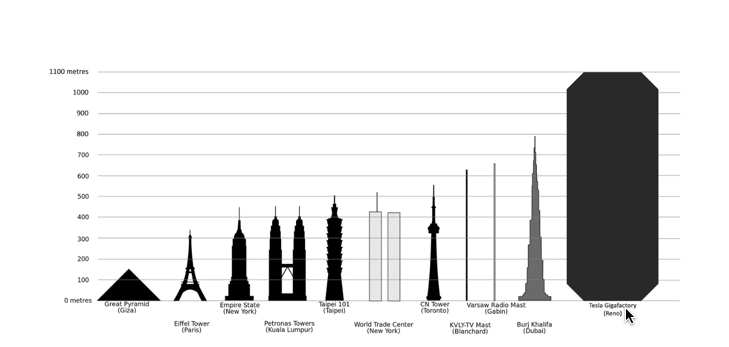The big news in American manufacturing recently is the Tesla Gigafactory. Most coverage on the battery plant focuses on size: how the completed factory can fit 50 billion hamsters inside, or almost a hundred 747s parked wing to wing.
Impressive as its scale is, size is among the least important things about the Gigafactory.
The shift into mega-scale manufacturing is what is truly gargantuan. Some 11 percent of the U.S. global domestic product is manufacturing. It contributes to 47 percent of U.S. exports and accounts for one in six jobs. By itself, manufacturing in the United States alone is the world’s 8th largest economy. It’s also the world’s largest energy consumer–accounting for a full 30 percent of the world’s energy consumption. It’s no wonder GE, recently in the New York Times, is documented as trying to change its strategy from owning equipment to building the software platforms the equipment runs on.
Here’s how the Gigafactory is a symbol of changing times–and huge new opportunities for emerging tech across the entire manufacturing footprint.
1. Integrated, product-centered factory design
Tesla’s re-engineered manufacturing method takes the product, and then engineers backward to a system that can build this product. The point of the factory-as-product is to reduce unit cost through intense process engineering and energy intelligence. (Imagine software that can do much the same thing for new products, building product + provisioning into a systematic approach.)
Why the Tesla Gigafactory is different
When you look at the history of manufacturing–call it mass production–it started with repetition and exchangeable parts. Among the first examples of this was when George Washington ordered the United States’ first 10,000 muskets. Our new government stipulated using the reusable-parts process invented by French gunsmith Honore Blanc. After a century of relative improvements in harnessing energy, from coal to steam to natural gas, Ford created a new system. It was the modern assembly line, with the product passing through stations instead of people going to work in shifts on the product. Toyota and others have updated the approach with quality engineering–often referred to as Six Sigma or Lean. In the last century, many of the stations on the assembly line have improved–like with robotics or RFID recognition–but the overall system of production hasn’t been fundamentally refigured since Ford.
Tesla Gigafactory represents a fundamental refocus of the system of manufacturing around the integrated product it is built to create at scale.
That fact leads to the following two other fundamental shifts that show how the Tesla Gigafactory is redefining “made in America.”
2. 5x-10x Increase in Production Capability
Tesla expects its Gigafactory to create a minimum five-fold increase in manufacturing output for its batteries–and perhaps as much as a 10-fold increase. “When you think about it, how did we improve your phone? It was by increasing the clockspeed and the density. The same principles apply to manufacturing,” says Elon Musk.
The Gigafactory has his stamp on its audacious system-thinking approach to reinventing a process from input and output fundamental variables. In the future, we might need a Musk’s law of manufacturing like we used Moore’s law as a thumb rule for chips. 10x production is a world that has a different logistics, different shipping solutions, different inventory–and different software running that at speed. Think VR-ennabled plant logistics systems, configurable distribution, and production learning systems.
3. Net Zero Emissions and Carbon-Neutral Manufacturing
The third way the Gigafactory is fundamentally changing manufacturing is energy efficiency. Musk’s opening remarks at the unveiling of the Tesla Gigafactory were, “Tesla’s mission is to accelerate the transition to sustainable energy.”
“One way to think of manufacturing efficiency is how long a journey did that molecule take from when it was mined. So if it was mined in one part of the world, and eventually does several trips around the world before it ends up in a finished product, that’s fundamentally expensive,” he says.
The Gigafactory is a production system designed to put as much energy back on the grid as it takes. Further, it’s also designed not to pollute air, ground, or water. This is carbon neutral, nonpolluting approach is so transformational that for much history of manufacturing, it has been considered impossible.
Tesla’s chief technical officer, JB Straubel was addressing a crowd of students at the University of Nevada when he said, “We are going to build a zero-emissions facility, just like that car. So, instead of fighting this battle in hindsight, we just said we are not even going to have a natural gas pipeline coming in to the factory, so we didn’t even build it. There’s a heat pump technology that is way more efficient than just burning natural gas for steam–and then, we have a facility that has basically no emissions.” While many startups have focused on the approximately 3,000 US utilities, the energy software of the future may well focus on the micro-, personal- and independent manufacturing grids–and still manage more than 30% of the world’s energy production.
This demand-centered production–where the product’s needs determine the most efficient production flow–turns manufacturing on its head. The net zero energy stance and design density reveal a unit economics approach that will revitalize how America makes things in the future. The next great American manufacturing frontier is here and new technology companies that create efficiencies within the new system are going to abound.
Originally published in my column in Inc. Magazine.

